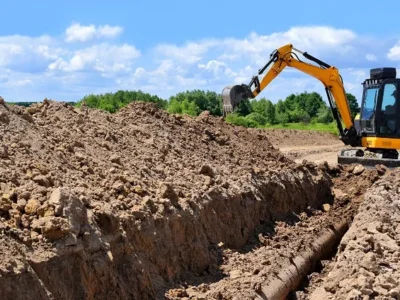The Growing Importance of Safety in Excavation
Excavation remains one of the most demanding aspects of construction and mining, requiring operators to work with heavy machinery in conditions that present inherent risks. Advancements in safety technology have significantly reduced workplace incidents, ensuring that operators, ground personnel, and surrounding environments are protected from potential hazards. With manufacturers continuously improving their designs, modern excavation equipment is now equipped with sophisticated features that enhance operational security, minimize accidents, and improve overall site management.
1. Proximity Detection and Collision Avoidance Systems
One of the leading causes of excavation-related accidents stems from collisions between heavy machinery, site workers, and nearby structures. Proximity detection systems, powered by radar, LiDAR, and ultrasonic sensors, have been integrated into modern excavators to prevent such incidents.
- Radar-Based Alerts: High-frequency radar sensors detect obstacles within a predefined range, sending alerts to the operator before a collision can occur.
- 360-Degree Camera Systems: Multi-angle cameras provide real-time visibility, eliminating blind spots and enhancing spatial awareness, particularly in confined work zones.
- Automatic Braking Mechanisms: Some advanced systems can override operator inputs and apply emergency braking when an imminent collision is detected, reducing the risk of impact.
These innovations are particularly valuable in high-traffic excavation sites, where multiple machines operate simultaneously and human error can lead to dangerous situations.
2. Rollover Protection Systems (ROPS) and Falling Object Protection Systems (FOPS)
Excavators, especially those operating on unstable terrain, are vulnerable to rollovers and falling debris. Engineers have addressed these risks by designing machines with reinforced cabins that withstand extreme conditions.
- ROPS (Rollover Protection Systems): These reinforced structures prevent cabin deformation in the event of a machine tipping over, shielding the operator from fatal injuries.
- FOPS (Falling Object Protection Systems): Excavators working in environments such as demolition sites or quarries often face the risk of falling debris. FOPS-certified cabins feature impact-resistant materials that protect operators from overhead hazards.
- Suspension-Integrated Seats: Shock-absorbing seats further reduce the impact on operators during rollovers or abrupt movements, preventing spinal injuries.
With these safety measures in place, excavation professionals can operate in rugged terrains with significantly reduced personal risk.
3. Smart Hydraulic Locking Mechanisms
Hydraulic systems are at the core of excavation machinery, controlling everything from boom movements to bucket positioning. Malfunctions or accidental activations have historically led to hazardous situations, but modern locking mechanisms have transformed safety standards.
- Automatic Hydraulic Locking: This feature ensures that hydraulic controls remain locked when the machine is not actively in use, preventing unintended movements that could endanger workers nearby.
- Operator Presence Detection: Excavators are now fitted with sensors that detect whether an operator is seated and engaged with controls. If no presence is detected, hydraulic functions are disabled, reducing the likelihood of accidental engagement.
- Emergency Hydraulic Shutoff: In the event of hydraulic failure, an emergency shutoff valve stops all movement, preventing uncontrolled machine behavior.
By integrating these smart hydraulic safety systems, manufacturers have significantly minimized operational risks associated with sudden or unintended movements.
4. Remote Operation and Autonomous Excavation
Advancements in automation have introduced remote operation capabilities, allowing operators to control excavation equipment from a safe distance. This innovation is particularly beneficial in hazardous environments, such as mining operations with unstable ground conditions or disaster recovery sites with structural risks.
- Radio-Controlled Operation: Excavators equipped with remote-control systems enable operators to maneuver machinery from a secure location, eliminating exposure to dangerous conditions.
- Semi-Autonomous Digging: Some modern excavation machines can be programmed to perform repetitive digging tasks autonomously, reducing human involvement in high-risk zones.
- Collision-Free Navigation: Autonomous excavation systems rely on advanced sensors and GPS technology to navigate sites without human intervention, further minimizing potential safety concerns.
These technologies not only enhance safety but also improve efficiency by reducing fatigue-related errors among operators.
5. Intelligent Operator Assistance and Fatigue Monitoring
Excavation work demands high levels of concentration, and fatigue remains a significant factor in workplace accidents. Modern machinery integrates intelligent operator assistance systems to detect signs of fatigue and prevent errors.
- Eye-Tracking and Facial Recognition: Sensors within the cabin monitor eye movements and facial expressions, identifying early signs of drowsiness. If fatigue is detected, audible alerts or seat vibrations prompt the operator to take necessary precautions.
- Adaptive Control Sensitivity: Machines can adjust control responsiveness based on detected fatigue levels, reducing the likelihood of sudden, unintended movements.
- Work Cycle Optimization: AI-powered software analyzes work patterns and suggests breaks or workload adjustments to maintain operator performance and safety.
By prioritizing operator well-being, these advancements ensure sustained efficiency without compromising safety.
6. Advanced Fire Suppression and Emergency Response Systems
Given the high temperatures and flammable materials often encountered on excavation sites, fire prevention is a critical safety consideration. Modern excavators are now equipped with automatic fire suppression systems to reduce the risk of onboard fires.
- Heat-Sensitive Fire Detection: Infrared sensors monitor engine and hydraulic temperatures, identifying potential fire hazards before ignition occurs.
- Automated Fire Suppression: In case of fire, built-in suppression systems release specialized extinguishing agents, preventing flames from spreading.
- Quick-Escape Cabin Features: Excavator cabins now feature improved emergency exits, allowing operators to evacuate swiftly in critical situations.
With these enhancements, excavation sites are better prepared to handle emergencies, protecting both personnel and equipment.
7. Enhanced Communication and Site Monitoring Technologies
A well-coordinated excavation site requires seamless communication between operators, supervisors, and ground personnel. The introduction of real-time monitoring and communication technologies has improved situational awareness and emergency response efficiency.
- Wireless Communication Systems: Excavators are now equipped with onboard communication devices that allow direct contact with supervisors and site managers.
- GPS Tracking and Geofencing: These technologies monitor equipment location, ensuring that excavators operate within designated areas while preventing unauthorized use.
- Augmented Reality (AR) Displays: Some modern excavators feature heads-up displays (HUDs) that provide real-time data overlays, allowing operators to make precise adjustments without diverting attention from tasks.
By integrating these communication enhancements, excavation sites maintain better coordination, reducing the likelihood of miscommunication-related accidents.
A Future Defined by Safety and Innovation
Excavation equipment safety has advanced far beyond simple protective measures. Today’s machinery integrates intelligent systems that anticipate risks, automate responses, and create a secure working environment for operators and site personnel. As technology continues to progress, manufacturers will refine these safety features further, ensuring that excavation remains an efficient yet secure component of construction and resource extraction.













Comments